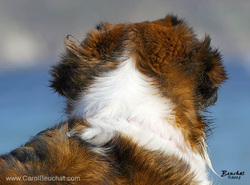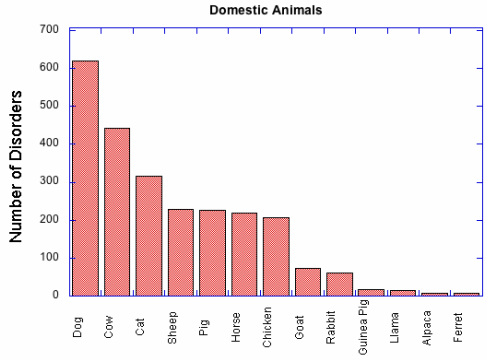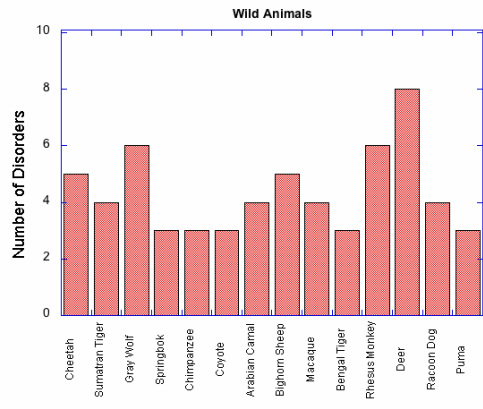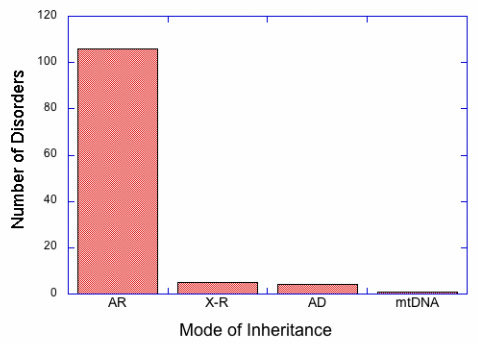
The list of canine genetic diseases seems to get longer every day, and you have to wonder if this is "normal". Of course, all animals have inherited disorders, but is the dog typical of other animals?
One of the best online resources for information about genetic traits in mammals and birds is OMIA - Online Mendelian Inheritance in Animals. It contains information on both domestic and wild animals, and even a few birds and fish. Displayed are the total number of traits or disorders they have information for, as well as the particular gene or mutation if known.

This first graph shows the number of diseases or traits they have information for in a variety of domestic animals.
Dog outstrip all other species in the number of documented genetic disorders, with 619, followed (far behind) by the domestic cow with 443. From there the numbers decline (219 in the horse, 18 in the guinea pig, 7 in the ferret). A number of these animals are commercially bred (e.g., cows, sheep, pigs), while others are kept as pets (e.g, cat, guinea pig), or for food or wool (e.g, goat, llama, alpaca).

Why is this?

The OMIA table lists a total of 619 traits/disorders for dogs, 240 of which are thought to be Mendelian, and for 165 of those the mutation and mode of inheritance is known.
Let's look at the mode of inheritance for the diseases where it is known. I've divided mode of inheritance into 4 types - AR (autosomal recessive), X-R (X-linked recessive), AD (autosomal dominant), and mtDNA (mitochondrial DNA, which can only come from the mother).
By far, the majority of disorders for which mode of inheritance is known are autosomal recessive. Recessive genes are only expressed if the animal gets two copies of the allele, one from the father and one from the mother, a condition called homozygous. So both parents had to have at least one copy of this particular allele.
The thing to realize about autosomal recessive genes is there there are lots of them lurking in the genome of every animal. Mutations happen all the time: if the mutated gene is dominant, the trait is expressed and if it compromises the health of the animal it can be removed from the population by culling (either by nature or by breeder). If the mutated gene is recessive, however, it is not expressed, so it remains hidden, to nature and the breeder. As long as these recessive alleles are fairly rare in the breed, they can hang out there for generations with no ill effects.
If one popular dog produces many offspring, lots of copies of its genes, both good and bad, are introduced into the population. As the number of copies of the lurking recessive alleles increases in the population, the chances grow that two dogs will get paired up that both have a particular recessive allele, and that's when you start seeing affected - homozygous - puppies. The size of the population can be important here - in a breed with tens of thousands of dogs (think Labrador or Golden Retriever), there have to be many more copies of the bad allele produced (in the form of puppies) than if the entire breeding population is just a few hundred dogs (think rare breeds like the Chinook or Icelandic Sheepdog). Small breeds are much more vulnerable to the accumulation of recessive alleles, and there is a much higher risk of the allele becoming "fixed" in the breed (i.e., all individuals are homozygous for the bad allele).
The other way to end up with affected puppies, even if the frequency of the recessive allele in the population is very low, is by breeding closely related dogs. A sire carrying a bad allele that is bred to a granddaughter stands a good chance of producing homozygous pups - and both copies of the bad allele could actually came from him. (This is called (homozygous by descent", meaning both copies of the allele were inherited from the same ancestor.)
So back to the graph above. Most genetic diseases in dogs are a consequence of paired autosomal recessive alleles, and this has occurred because of the breeding practices we just discussed. This means that these diseases were entirely AVOIDABLE. It's no mystery why the list of inherited disorders continues to get longer, and if you think you are in a "relatively healthy" breed think again. There are bad alleles in ALL dogs. You have no way to know which are in your dogs, or even your breed, until they are expressed.
This is a tough problem, but not a new one. Livestock breeders found themselves in a similar situation several decades ago. With the advent of commercial farming and new reproductive technologies, hundreds of genetically identical embryos could be produced from the best bull and cow by implantation into surrogate cows. This created artificial bottlenecks (most animals produced no offspring with their genes), genetic diversity in the breeds drastically declined, and inbreeding depression began to take a toll. What turned things around was the adoption of breeding strategies that resulted in genetic improvement of the stock while at the same time protecting the genetic health of the entire breed.
These techniques work for livestock, and they also work for dogs. In fact, organizations that maintain breeding colonies to produce service dogs have been using these breeding techniques for decades, and with great success. The topic for another post...

